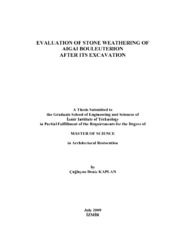Please use this identifier to cite or link to this item:
https://hdl.handle.net/11147/4037Full metadata record
| DC Field | Value | Language |
|---|---|---|
| dc.contributor.advisor | İpekoğlu, Başak | en |
| dc.contributor.author | Kaplan, Çağlayan Deniz | - |
| dc.date.accessioned | 2014-07-22T13:53:03Z | - |
| dc.date.available | 2014-07-22T13:53:03Z | - |
| dc.date.issued | 2009 | en |
| dc.identifier.uri | http://hdl.handle.net/11147/4037 | - |
| dc.description | Thesis (Master)--Izmir Institute of Technology, Architectural Restoration, Izmir, 2009 | en |
| dc.description | Includes bibliographical references (leaves: 134-138) | en |
| dc.description | Text in English; Abstract: Turkish and English | en |
| dc.description | xiii, 138 leaves | en |
| dc.description.abstract | Archaeological sites have to be investigated and conserved as a whole to have a better knowledge of our past. In this study, Aigai Bouleuterion in Manisa was investigated to evaluate the stone weathering and conservation problems of an excavated archaeological monument. It is also aimed to analyze the weathering process of stone material while buried and the contribution of this process to the deterioration after the excavation. For this purpose, the building was documented by photographs and drawings and several laboratory studies were carried out on both the soil and stone samples collected from the excavated parts of the building. Samples were investigated with by using XRD, SEM-EDX, TGA and FT-IR and chemical analyses. Andesite, used as a building material of the bouleuterion and the soils are both composed of the minerals of microline, orthoclase, sanidine, albite, andesine, labradorite, anorthite, muscovite, cristoballite, tridymite, quartz, kyanite, mullite and orthoferrosilite. Less amounts of organic materials, carbonate and soluble salt contents were found in the samples. The clay minerals found in the samples are halloysite, illite, kaolinite, montmorrillonite and saponite.The penetration of clay minerals to the stone structure, forming a weathering zone with the presence of clay in the cracks was determined with SEM analysis. The weathering zones of the stones range between 1 cm and 2.4 cm from the exterior surface. When the average seasonal values for the environment are examined, the weathering effect of the clays after excavation of stones generally occurs in winter months due to low temperature and high humidity values. | en |
| dc.language.iso | en | en_US |
| dc.publisher | Izmir Institute of Technology | en |
| dc.rights | info:eu-repo/semantics/openAccess | en_US |
| dc.subject.lcc | NA109.T9 .K17 2009 | en |
| dc.subject.lcsh | Historic sites--Conservation and restoration | en |
| dc.subject.lcsh | Stone buildings--Conservation and restoration | en |
| dc.subject.lcsh | Excavations(Archaelogy)--Turkey | en |
| dc.subject.lcsh | Weathering of buildings | en |
| dc.title | Evalution of stone weathering of Aigai Bouleuterion after its excavation | en_US |
| dc.type | Master Thesis | en_US |
| dc.institutionauthor | Kaplan, Çağlayan Deniz | - |
| dc.department | Thesis (Master)--İzmir Institute of Technology, Conservation and Restoration of Cultural Heritage | en_US |
| dc.relation.publicationcategory | Tez | en_US |
| item.languageiso639-1 | en | - |
| item.fulltext | With Fulltext | - |
| item.openairecristype | http://purl.org/coar/resource_type/c_18cf | - |
| item.openairetype | Master Thesis | - |
| item.grantfulltext | open | - |
| item.cerifentitytype | Publications | - |
| Appears in Collections: | Master Degree / Yüksek Lisans Tezleri Sürdürülebilir Yeşil Kampüs Koleksiyonu / Sustainable Green Campus Collection | |
Files in This Item:
| File | Description | Size | Format | |
|---|---|---|---|---|
| T000785.pdf | MasterThesis | 81.2 MB | Adobe PDF |  View/Open |
CORE Recommender
Page view(s)
98
checked on Jul 22, 2024
Download(s)
38
checked on Jul 22, 2024
Google ScholarTM
Check
Items in GCRIS Repository are protected by copyright, with all rights reserved, unless otherwise indicated.